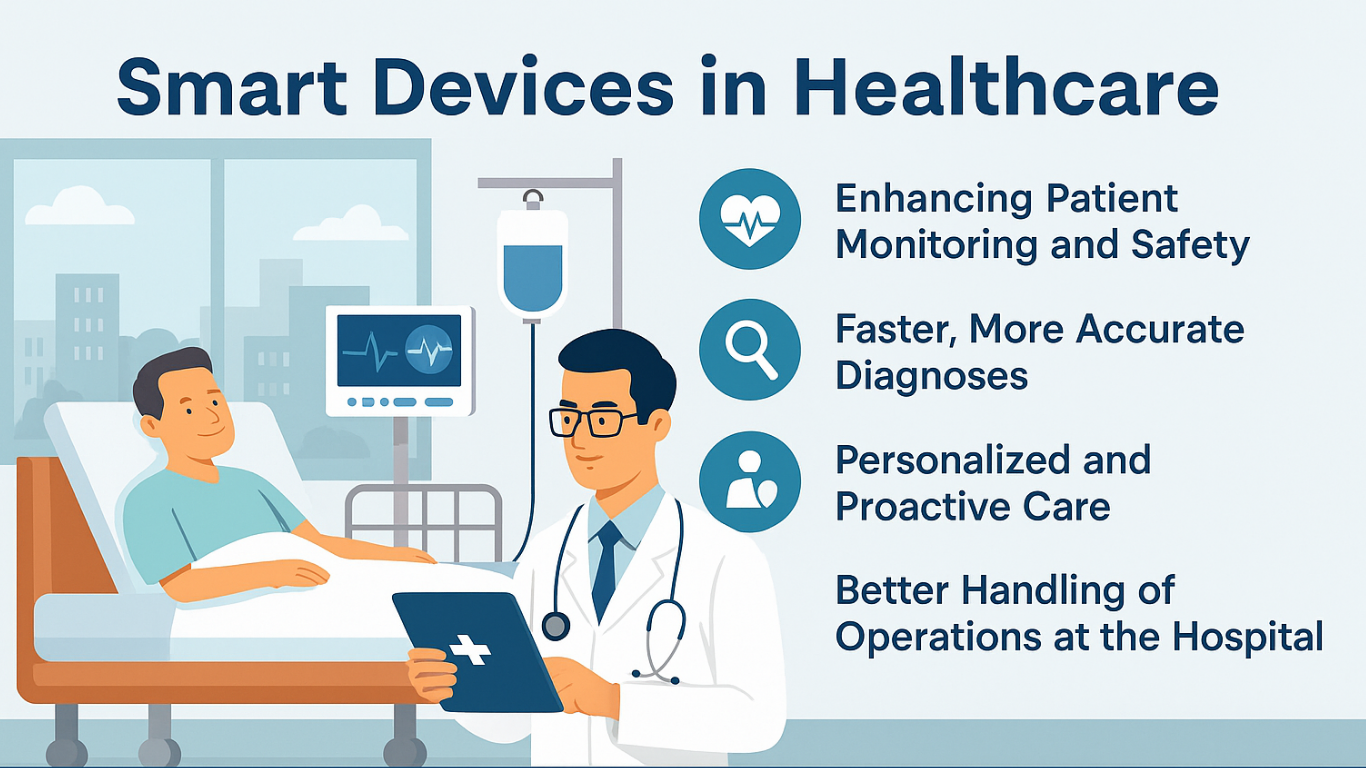The Role of Smart Devices in Improving Patient Outcomes in Hospitals
Nowadays, hospitals are using smart devices in their clinical work to improve how they work, make diagnoses and especially care for patients. With healthcare progressing in 2025, smart medical devices are important because they help turn real-time data into useful insights for doctors and nurses. Now, wearable monitors and AI used in imaging are standard parts of medical care, rather than science fiction.
What Do We Mean by Smart Medical Devices?
Such devices are healthcare tools that contain sensors, can connect wirelessly and process data. With these devices, data is gathered, checked and sent quickly to healthcare teams, helping them make better and faster choices. For example, smart infusion pumps, ECG monitors that can be worn, digital stethoscopes, networked hospital beds and mobile diagnostic tools are included. Thanks to being part of a network, smart devices can work with hospital information systems (HIS), electronic health records (EHR) and cloud-based services.
Enhancing Patient Monitoring and Safety
A main advantage of smart devices is they can constantly monitor patients’ vital signs from anywhere inside the hospital. For example, heart monitors that are worn and wireless pulse oximeters make it possible to:
-
Collecting data at all times while not limiting how patients move
-
Warnings immediately notifying staff when oxygen levels or heart rate are abnormal
-
Generate reports that are automatically added to the patient’s electronic record
It allows for less manual charting and helps lower the chance of mistakes by people. With smart monitoring, staff is warned before a critically ill or post-operative patient’s condition worsens which could save their life.
Faster, More Accurate Diagnoses
Tools powered by AI for images and portable ultrasound systems give clinicians better opportunities to diagnose patients quickly and correctly. They rely on complex algorithms to spot things that traditional methods might overlook. Examples include:
-
CT and MRI devices that use AI to identify possible problems
-
AI analysis can be used to study heart and lung sounds that are recorded by digital stethoscopes
-
Test instruments that provide speedy and reliable results with only a small role for humans Using better diagnostics allows doctors to treat illnesses sooner which is often very important for patient recovery.
Personalized and Proactive Care
With smart devices, people can switch from simply treating problems to taking action ahead of time and with care that fits their needs. Because they keep gathering data, these devices help doctors notice patterns or signs of trouble while they are still minor. For example:
-
Real-time glucose monitoring helps the pump to change the amount of insulin it delivers.
-
You can see your asthma medicine use in the app and get reminders when it’s time for your next dose.
-
Sleep monitors can help diagnose conditions that might not be found otherwise
-
Because the data is so detailed, care teams can customize treatment and act early, resulting in better long-term results.
Better handling of operations at the hospital
Outside the patient environment, smart devices help hospitals work more efficiently which also benefits patients. Error-free medication is possible with smart infusion pumps which handle the calculation of doses. With pressure sensors, smart beds shield patients from bedsores and let nurses know if someone tries to move without supervision. In addition, using inventory systems in hospitals makes it possible to order supplies in time, helping to avoid delays caused by unavailable equipment or medicine.
Empowering Clinicians and Patients Alike
In addition to helping clinicians, smart medical devices also get patients involved in their care. Many devices let patients see their condition, helping them stick to their treatment guidelines. For instance:
-
If a tablet is attached to a smart monitor, patients can watch their progress.
-
By using smart scales and fitness trackers, people are encouraged to join in their recovery.
-
Telehealth kits help people get medical advice from a distance.
-
Including patients in their care, smart devices build trust and responsibility which are both connected to better results.
Challenges and Considerations
Still, smart devices bring about some issues:
-
The risks of privacy and security for data
-
Costs that are paid at the beginning
-
Being able to communicate with current systems
-
Employees training and acceptance The best results come when hospitals secure their systems, use devices that fit their environment and train their staff to encourage use of the new technology.
The Future Outlook
With the IoMT growing, smart devices will play a bigger part in hospitals. Shortly, we will likely see even more complex tools being developed.
-
Using AI, predictive analytics helps in preventing health issues.
-
Surgical robots that improve their performance over time
-
Every device in a fully integrated smart ward works flawlessly together. Using real-time data, automation and advanced analytics will improve how hospitals care for patients and drive them toward a new age of precision medicine.
Conclusion
The integration of smart devices in hospitals marks a transformative shift toward proactive, data-driven healthcare. From AI-powered diagnostics to connected monitoring systems, these tools empower clinicians and patients alike while enhancing safety and operational efficiency. To stay ahead in this evolving landscape, healthcare institutions can turn to Equipmedy—a trusted resource for sourcing cutting-edge medical technology that supports better outcomes and future-ready care environments.
When hospitals adopt smart technology, patients will enjoy earlier diagnosis, fewer problems and improved health results.
